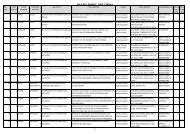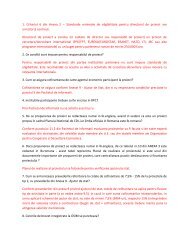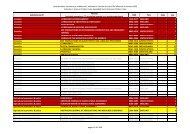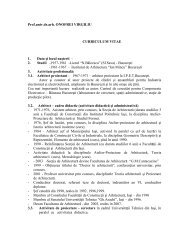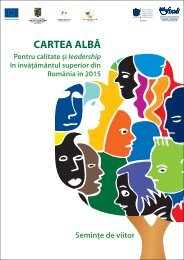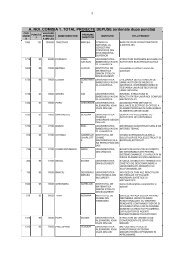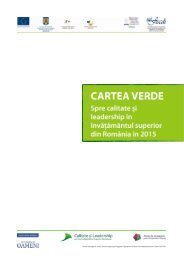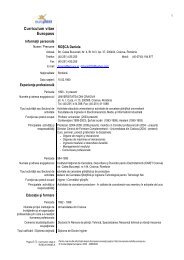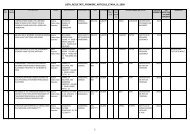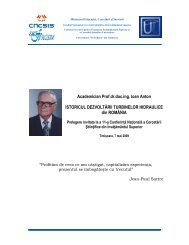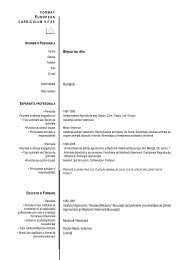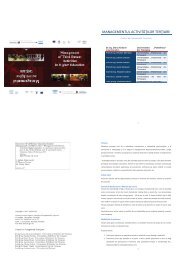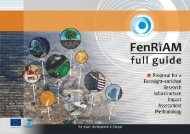Povesti de succes - uefiscdi
Povesti de succes - uefiscdi
Povesti de succes - uefiscdi
Create successful ePaper yourself
Turn your PDF publications into a flip-book with our unique Google optimized e-Paper software.
Robotică şi realitate virtuală<br />
24<br />
Robotică şi realitate virtuală<br />
Profesor univ. dr. ing. Doru Talabă<br />
Universitatea “Transilvania” din Brașov<br />
Telefon:+40 268 418967<br />
Fax: +40 268 418967<br />
Email: Talaba@unitbv.ro<br />
Scurtă prezentare a activităţii <strong>de</strong> cercetare<br />
În anul 2002, au fost iniţiate primele cercetari în cadru<br />
organizat in domeniul realitatii virtuale ca urmare a <strong>de</strong>rulării<br />
primelor 2 proiecte FP5 din Universitatea Transilvania<br />
(IRMA şi ADEPT), câştigate <strong>de</strong> către o echipa <strong>de</strong> cercetare<br />
din catedra Design <strong>de</strong> Produs şi Robotică, care au asigurat<br />
astfel finanţarea realizarii primelor elemente <strong>de</strong> infrastructură.<br />
S-a putut astfel infiinta laboratorul <strong>de</strong> CAD-CAE şi Realitate<br />
Virtuală, cu scopul <strong>de</strong>clarat încă <strong>de</strong> la început <strong>de</strong> a<br />
<strong>de</strong>fini o entitate <strong>de</strong> cercetare ştiinţifică mo<strong>de</strong>rnă, dupa<br />
mo<strong>de</strong>lul centrelor <strong>de</strong> cercetare Europene, capabilă să participe<br />
în competiţia cercetării ştiinţifice pe plan European.<br />
În anul 2004, prin fuziune cu direcţia <strong>de</strong> cercetare Robotica,<br />
a fost înfiinţată la nivelul Catedrei DPR direcţia <strong>de</strong><br />
cercetare Robotică şi Realitate Virtuală.. Sub aceasta <strong>de</strong>numire,<br />
direcţia <strong>de</strong> cercetare se încadrează perfect în priorităţile<br />
<strong>de</strong>finite în programele Europene FP6 şi FP7 care includ în<br />
mod explicit ambele domenii în prioritatea IST-FP6 respectiv<br />
ICT – FP7.<br />
Conţinutul direcţiei <strong>de</strong> cercetare este în mod direct orientat<br />
către susţinerea disciplinelor tradiţionale ale catedrei<br />
(pornind <strong>de</strong> la Mecanisme , Organe <strong>de</strong> Maşini şi CAD, şi<br />
continuând cu disciplinele din domeniul CAE - Metoda Elementului<br />
Finit şi Metoda Sistemelor Multicorp), precum şi<br />
pentru susţinerea specializarilor înfiinţate dupa 1990, şi<br />
anume Robotică şi Design <strong>de</strong> Produs.<br />
În prezent, mare parte din activitatea unui inginer este<br />
compusa din activităţi specifice IT - ca rezultat al faptului<br />
ca pon<strong>de</strong>rea in PIB-ul mondial a veniturilor provenite din<br />
IT este în continuă creştere. Acest lucru explică şi faptul că<br />
în FP7, numeroase discipline încadrate până <strong>de</strong> curând în inginerie<br />
se regăsesc acum în domeniul ICT, aşa cum este <strong>de</strong><br />
exemplu cazul Roboticii, fără a mai menţiona discipline precum<br />
CAD şi CAE, care sunt încadrate la prioritatea ICT încă<br />
<strong>de</strong> la programul FP6.<br />
Realitatea Virtuală, un subdomeniu al tehnologiei IT,<br />
este astăzi privită ca tehnologia viitorului <strong>de</strong> interfaţare ommaşină.<br />
În acest context, disciplinele din domeniul CAD,<br />
CAE şi Robotică sunt nemijlocit legate <strong>de</strong> <strong>de</strong>zvoltarea<br />
cercetărilor din acest domeniu <strong>de</strong> vîrf. Situarea acestui<br />
subiect <strong>de</strong> cercetare în centrul direcţiei <strong>de</strong> cercetare, <strong>de</strong>şi în<br />
aparenţă nu corespun<strong>de</strong> unei discipline didactice din fluxul<br />
principal pentru ingineria mecanică, este expresia expansi-<br />
Robotics and Virtual Reality<br />
Brief Presentation of Research Activity<br />
In 2002, the first research group in the field of Virtual<br />
Reality was created as a result of the first two FP5 projects<br />
at the “Transilvania” University (IRMA and ADEPT), won<br />
by a small research team of the Product Design and Robotics<br />
(PDR) Department. The projects assured the funding for<br />
the realization of the first infrastructure elements. Thus the<br />
CAD-CAE and the Virtual Reality Laboratory was foun<strong>de</strong>d;<br />
its goal, stated from the beginning, was to <strong>de</strong>velop a mo<strong>de</strong>rn<br />
scientific research entity, following the mo<strong>de</strong>l of the European<br />
research centers, that would be capable to get involved<br />
into scientific research at a European level.<br />
In 2004, after a fusion with the Robotics research division,<br />
the "Robotics and Virtual Reality" research direction<br />
was foun<strong>de</strong>d at the level of the PDR Department. The new<br />
research direction matches perfectly with the priorities <strong>de</strong>fined<br />
by the FP6 and FP7 European programmes, which explicitly<br />
inclu<strong>de</strong> the two related fields into the IST-FP6 and<br />
ICT-FP7 priorities.<br />
The content of the research direction is oriented to sustain<br />
the traditional disciplines of the Department (starting<br />
with Mechanisms, Machine Components, CAD up to the<br />
CAE disciplines – Finite element method and Multi-body<br />
System Dynamics) and also to sustain the Robotics and<br />
Product Design, two of the specializations foun<strong>de</strong>d after<br />
1990.<br />
Presently, a great part of an engineer’s activity is composed<br />
by IT specific activities – as a result of the continuous<br />
growth of the IT incomes into the worldwi<strong>de</strong> GDP. This also<br />
explains the fact that in FP7, a lot of the disciplines that were<br />
until recently inclu<strong>de</strong>d in the engineering field now belong<br />
to the ICT field. This is also the case with Robotics, and disciplines<br />
like CAD and CAE, that have been inclu<strong>de</strong>d into<br />
the ICT priority beginning with the FP6 programme.<br />
The Virtual Reality, a sub-domain of IT technology, is<br />
presently regar<strong>de</strong>d as the future human-machine interfacing<br />
technology. In this context, the disciplines belonging to the<br />
CAD, CAE and Robotics fields are directly related to the<br />
<strong>de</strong>velopment of research activities in this domain. The fact<br />
that this research subject is located in the center of the RRV<br />
research direction, though apparently it doesn’t correspond<br />
to a didactical discipline from the main flow of the mecha-



